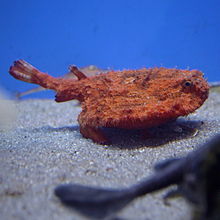Ogcocephalidae
| Ogcocephalidae | |
|---|---|

| |
| Halieutaea stellata in Takeshima Aquarium, Japan | |
| Scientific classification | |
| Domain: | Eukaryota |
| Kingdom: | Animalia |
| Phylum: | Chordata |
| Class: | Actinopterygii |
| Order: | Lophiiformes |
| Suborder: | Ogcocephaloidei |
| Family: | Ogcocephalidae D. S. Jordan, 1895 |
| Genera | |
|
Coelophrys | |
Ogcocephalidae is a family of anglerfish specifically adapted for a benthic lifestyle of crawling about on the seafloor. Ogcocephalid anglerfish are sometimes referred to as batfishes,[1][2] deep-sea batfishes,[3] handfishes, and seabats.[4] They are found in tropical and subtropical oceans worldwide.[2] They are mostly found at depths between 200 and 3,000 m (660 and 9,840 ft), but have been recorded as deep as 4,000 m (13,000 ft).[2][5] A few species live in much shallower coastal waters and, exceptionally, may enter river estuaries.[2]
They are dorsoventrally compressed fishes similar in appearance to rays, with a large circular or triangular head (box-shaped in Coelophrys), and a small tail. The largest members of the family are approximately 50 cm (20 in) in standard length. The illicium (a modified dorsal fin ray on the front of the head supporting the esca, a bulbous lure) may be retracted into an illicial cavity above the mouth. The esca is not luminous, as in most other groups of anglerfishes, but secretes a fluid, lasting approximately two minutes, thought to act as a chemical lure which attracts prey such as crabs, snails, shrimp, and small fish.[6][7] Analysis of their stomach contents indicates that batfishes feed on fish, crustaceans, and polychaete worms.[5]
The pelvic and anal fins of many species are stout and thick-skinned, so as to support the body off the substrate. These fins also enable batfishes to walk on the seafloor, though the irregular shape of the fins causes most batfishes to swim awkwardly.
This family grouping contains approximately ten genera and 75 known species found in almost all tropical seas around the world.[8]
Gallery
-
Painting of Halieutaea stellata by Kawahara Keiga, 1825
-
The longnose seabat (Malthopsis lutea)
References
- ^ Derouen, V., et al. (2015). Examining evolutionary relationships and shifts in depth preferences in batfishes (Lophiiformes: Ogcocephalidae). Molecular Phylogenetics and Evolution 84, 27-33.
- ^ a b c d Family Ogcocephalidae - Batfishes. FishBase. 2016.
- ^ Bray, D. J. 2012. Ogcocephalidae: Deep-sea Batfishes. Fishes of Australia, accessed 07 May 2016.
- ^ Ogcocephalidae. Australian Museum.
- ^ a b Bertelsen, F. & Pietsch, T.W. (1998). Paxton, J.R. & Eschmeyer, W.N. (eds.). Encyclopedia of Fishes. San Diego: Academic Press. pp. 139–140. ISBN 0-12-547665-5.
- ^ Theodore W. Pietsch (2005). "Ogcocephalidae". Tree of Life web project. Retrieved 4 April 2006.
- ^ (Nagareda & Shenker, 2009)
- ^ Derouen, et al. 2014
Rade, C. M. (2011). Functional fin morphology of aquatic substrate-based locomotion in ogcocephalid fishes (Lophiiformes;Ogcocephalidae). Integrative and Comparative Biology., 51, E241–E241.
Derouen, V. (2015). Examining evolutionary relationships and shifts in depth preferences in batfishes (Lophiiformes: Ogcocephalidae). Molecular Phylogenetics and Evolution., 84, 27–33. https://doi.org/10.1016/j.ympev.2014.12.011
External links
 Media related to Ogcocephalidae at Wikimedia Commons
Media related to Ogcocephalidae at Wikimedia Commons


